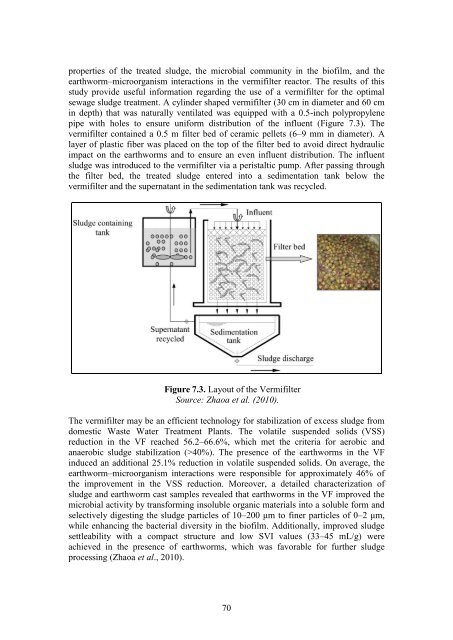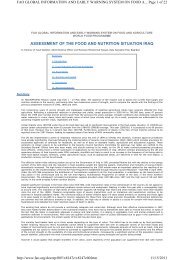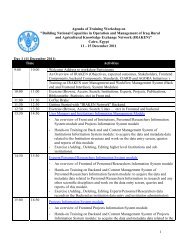Vermiculture in Egypt: - FAO - Regional Office for the Near East and
Vermiculture in Egypt: - FAO - Regional Office for the Near East and
Vermiculture in Egypt: - FAO - Regional Office for the Near East and
You also want an ePaper? Increase the reach of your titles
YUMPU automatically turns print PDFs into web optimized ePapers that Google loves.
properties of <strong>the</strong> treated sludge, <strong>the</strong> microbial community <strong>in</strong> <strong>the</strong> biofilm, <strong>and</strong> <strong>the</strong><br />
earthworm–microorganism <strong>in</strong>teractions <strong>in</strong> <strong>the</strong> vermifilter reactor. The results of this<br />
study provide useful <strong>in</strong><strong>for</strong>mation regard<strong>in</strong>g <strong>the</strong> use of a vermifilter <strong>for</strong> <strong>the</strong> optimal<br />
sewage sludge treatment. A cyl<strong>in</strong>der shaped vermifilter (30 cm <strong>in</strong> diameter <strong>and</strong> 60 cm<br />
<strong>in</strong> depth) that was naturally ventilated was equipped with a 0.5-<strong>in</strong>ch polypropylene<br />
pipe with holes to ensure uni<strong>for</strong>m distribution of <strong>the</strong> <strong>in</strong>fluent (Figure 7.3). The<br />
vermifilter conta<strong>in</strong>ed a 0.5 m filter bed of ceramic pellets (6–9 mm <strong>in</strong> diameter). A<br />
layer of plastic fiber was placed on <strong>the</strong> top of <strong>the</strong> filter bed to avoid direct hydraulic<br />
impact on <strong>the</strong> earthworms <strong>and</strong> to ensure an even <strong>in</strong>fluent distribution. The <strong>in</strong>fluent<br />
sludge was <strong>in</strong>troduced to <strong>the</strong> vermifilter via a peristaltic pump. After pass<strong>in</strong>g through<br />
<strong>the</strong> filter bed, <strong>the</strong> treated sludge entered <strong>in</strong>to a sedimentation tank below <strong>the</strong><br />
vermifilter <strong>and</strong> <strong>the</strong> supernatant <strong>in</strong> <strong>the</strong> sedimentation tank was recycled.<br />
Figure 7.3. Layout of <strong>the</strong> Vermifilter<br />
Source: Zhaoa et al. (2010).<br />
The vermifilter may be an efficient technology <strong>for</strong> stabilization of excess sludge from<br />
domestic Waste Water Treatment Plants. The volatile suspended solids (VSS)<br />
reduction <strong>in</strong> <strong>the</strong> VF reached 56.2–66.6%, which met <strong>the</strong> criteria <strong>for</strong> aerobic <strong>and</strong><br />
anaerobic sludge stabilization (>40%). The presence of <strong>the</strong> earthworms <strong>in</strong> <strong>the</strong> VF<br />
<strong>in</strong>duced an additional 25.1% reduction <strong>in</strong> volatile suspended solids. On average, <strong>the</strong><br />
earthworm–microorganism <strong>in</strong>teractions were responsible <strong>for</strong> approximately 46% of<br />
<strong>the</strong> improvement <strong>in</strong> <strong>the</strong> VSS reduction. Moreover, a detailed characterization of<br />
sludge <strong>and</strong> earthworm cast samples revealed that earthworms <strong>in</strong> <strong>the</strong> VF improved <strong>the</strong><br />
microbial activity by trans<strong>for</strong>m<strong>in</strong>g <strong>in</strong>soluble organic materials <strong>in</strong>to a soluble <strong>for</strong>m <strong>and</strong><br />
selectively digest<strong>in</strong>g <strong>the</strong> sludge particles of 10–200 μm to f<strong>in</strong>er particles of 0–2 μm,<br />
while enhanc<strong>in</strong>g <strong>the</strong> bacterial diversity <strong>in</strong> <strong>the</strong> biofilm. Additionally, improved sludge<br />
settleability with a compact structure <strong>and</strong> low SVI values (33–45 mL/g) were<br />
achieved <strong>in</strong> <strong>the</strong> presence of earthworms, which was favorable <strong>for</strong> fur<strong>the</strong>r sludge<br />
process<strong>in</strong>g (Zhaoa et al., 2010).<br />
70





